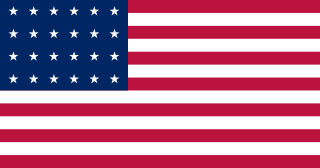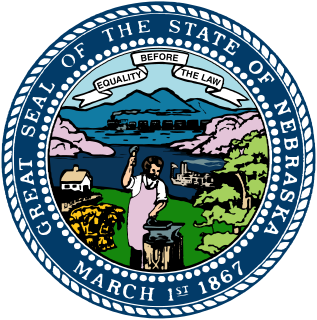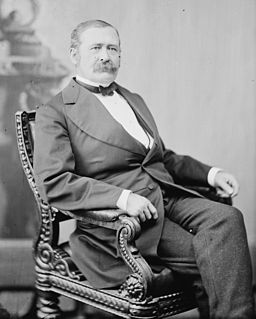Related Research Articles

The Indian Territory and the Indian Territories are terms that generally describe an evolving land area set aside by the United States Government for the relocation of Native Americans who held aboriginal title to their land as a sovereign independent state. In general, the tribes ceded land they occupied in exchange for land grants in 1803. The concept of an Indian Territory was an outcome of the US federal government's 18th- and 19th-century policy of Indian removal. After the American Civil War (1861–1865), the policy of the US government was one of assimilation.

Thayer County is a county in the U.S. state of Nebraska. As of the 2010 United States Census, the population was 5,228. Its county seat is Hebron. The county was created in 1856 and originally named Jefferson County. It was organized in 1870-1871 and renamed for General and Governor John Milton Thayer.

Scotts Bluff County is a county on the western border of the U.S. state of Nebraska. As of the 2010 United States Census, the population was 36,970. Its county seat is Gering, and its largest city is Scottsbluff.

Nuckolls County is a county located in the U.S. state of Nebraska. As of the 2010 United States Census, the population was 4,500. Its county seat is Nelson.

Jefferson County is a county in the U.S. state of Nebraska. As of the 2010 United States Census, the population was 7,547. Its county seat is Fairbury. The county was named for Thomas Jefferson, third President of the United States of America.

Kiowa County is a county located in the U.S. state of Kansas. As of the 2010 census, the county population was 2,553. The largest city and county seat is Greensburg.

Kiowa County is one of the 64 counties in the U.S. state of Colorado. As of the 2010 census, the population was 1,398, making it the fifth-least populous county in Colorado. The county seat is Eads. The county was named for the Kiowa Nation of Native Americans.

Alexandria is a village in Thayer County, Nebraska, United States. The population was 177 at the 2010 census.

Hebron is a city in, and the county seat of, Thayer County, Nebraska, United States. The population was 1,579 at the 2010 census.

Thayer is a village in York County, Nebraska, United States. The population was 62 at the 2010 census.

Kiowa people are a Native American tribe and an indigenous people of the Great Plains of the United States. They migrated southward from western Montana into the Rocky Mountains in Colorado in the 17th and 18th centuries, and finally into the Southern Plains by the early 19th century. In 1867, the Kiowa were moved to a reservation in southwestern Oklahoma.
Thayer may refer to:

The New England Emigrant Aid Company was a transportation company founded in Boston, Massachusetts by activist Eli Thayer in the wake of the Kansas–Nebraska Act, which allowed the population of Kansas Territory to choose whether slavery would be legal. The Company's ultimate purpose was to transport anti-slavery immigrants into the Kansas Territory. The Company believed that if enough anti-slavery immigrants settled en masse in the newly-opened territory, they would be able to shift the balance of political power in the territory, which in turn would lead to Kansas becoming a free state when it eventually joined the United States. The New England Emigrant Aid Company is noted less for its direct impact than for the psychological impact it had on pro-slavery and anti-slavery elements. Thayer's prediction that the Company would eventually be able to send 20,000 immigrants a year never came to fruition, but it spurred Border Ruffians from nearby Missouri, where slavery was legal, to move to Kansas to ensure its admission to the Union as a slave state. That, in turn, further galvanized Free-Staters and enemies of Slave Power.

George de Rue Meiklejohn was a Nebraska Republican politician who served as the fifth Lieutenant Governor of Nebraska under Governor John Milton Thayer and a member of the United States House of Representatives for Nebraska. He was the United States Assistant Secretary of War from 1897 to 1901.

The Nebraska Supreme Court is the highest court in the U.S. state of Nebraska. The court consists of a chief justice and six associate justices. Each justice is initially appointed by the governor of Nebraska; using the Missouri Plan, each justice is then subject to a retention vote for additional six-year terms. The six justices each represent a Supreme Court district; the chief justice is appointed at-large.

John Milton Thayer was a general in the Union Army during the American Civil War and a postbellum United States Senator from Nebraska. Thayer served as Governor of Wyoming Territory and Governor of Nebraska.

Melville Reeves Hopewell was a Nebraska lawyer and Republican politician who served as the state's lieutenant governor from 1907–1911.
Stoddard is a ghost town in Thayer County, Nebraska, United States.
Williams is a ghost town in Thayer County, Nebraska, United States.

Susie Peters was an American preservationist and matron at the Anadarko Agency, who worked to promote Kiowa artists. Born to white parents in Tennessee, she moved to Indian Territory with her family prior to Oklahoma statehood. While working as a matron for the Indian Agency, she discovered the talent of the young artists who would become known as the Kiowa Six and introduced them to Oscar Jacobson, director of the University of Oklahoma's art department. She was honored by the National Hall of Fame for Famous American Indians and both adopted by the tribe and given a Kiowa name in 1954. In 1963, the Anadarko Philomathic Club created an annual art award in her name. She was inducted into the Oklahoma Women's Hall of Fame in its inaugural year, 1982.
References
- ↑ U.S. Geological Survey Geographic Names Information System: Kiowa, Nebraska
- ↑ "Thayer County". Jim Forte Postal History. Retrieved 23 August 2014.
- ↑ Fitzpatrick, Lillian L. (1960). Nebraska Place-Names. University of Nebraska Press. p. 139. ISBN 0-8032-5060-6. A 1925 edition is available for download at University of Nebraska—Lincoln Digital Commons.
| This Thayer County, Nebraska state location article is a stub. You can help Wikipedia by expanding it. |
